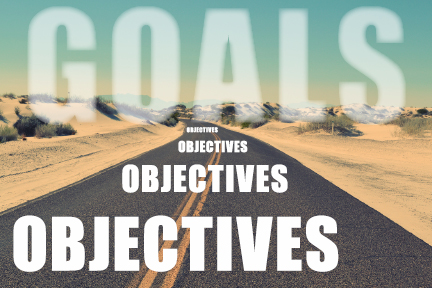In the world of business, it can be hard to distinguish between a goal and an objective, but the distinction is more than a matter of semantics. When discussing corporate strategy, the difference is critical.
While both are tools that business owners can use to compare where they are with where they want to be, goals represent that distant accomplishment and objectives are mile markers along the way. Goals can be as hazy as an image on the desert horizon, but an objective is fixed and measurable; it follows a series of steps or a timeline.
Goals are broad in scope and vision. Objectives are precise tasks that need to be completed for the goal to be achieved.
Concrete and Abstract
Strategic business planners set goals as aims they hope to accomplish over the long term. For a chile grower in Southern New Mexico, for example, a goal might be to generate more sales outside the state — a relatively abstract ambition.
Objectives are specific watersheds that mark progress toward the stated goal. Expanding distribution to retailers in Texas and Arizona, for example, are objectives that accomplish the larger goal of sales generation outside New Mexico.
Objectives are used to shape a business’ strategy for reaching a goal. They are written down and assigned start dates and deadlines. Resources are allocated to meet objectives, and performance measurements are applied to help planners decide whether the objective was met. Objectives can be tweaked at any stage if it helps the business more efficiently achieve the desired result — the goal.
A Vision — and a Road To Reach It
A company’s goals are often open-ended: They define general intentions, but they’re often so intangible and nonspecific that they’re hard to visualize.
A company might, for example, aspire to be a place where people of all religions and races and sexual orientations are comfortable and where harassment and discrimination don’t exist. While it’s hard to imagine what the company will look and feel like when the goal is reached, the company can set tangible objectives to mark its progress toward this utopic future.
It can set hiring and recruiting objectives to diversify the work force and training objectives to ensure all workers understand what behaviors and attitudes are expected of them. It can track complaints and other tangible evidence of workplace disharmony. It can set milestones for when the company expects the work force to mirror the community in which it’s based. All of these are solid objectives that the company can use to stay on course toward its more nebulous goal.
They might not be interchangeable terms or concepts, but goals and objectives are equally essential to the strategic equation: A goal can’t be reached without associated objectives, and objectives divorced from an ultimate goal just build a bridge that goes nowhere.
Download 351_Knowing the Difference Between Goals Objectives Critical in Business Planning PDF

